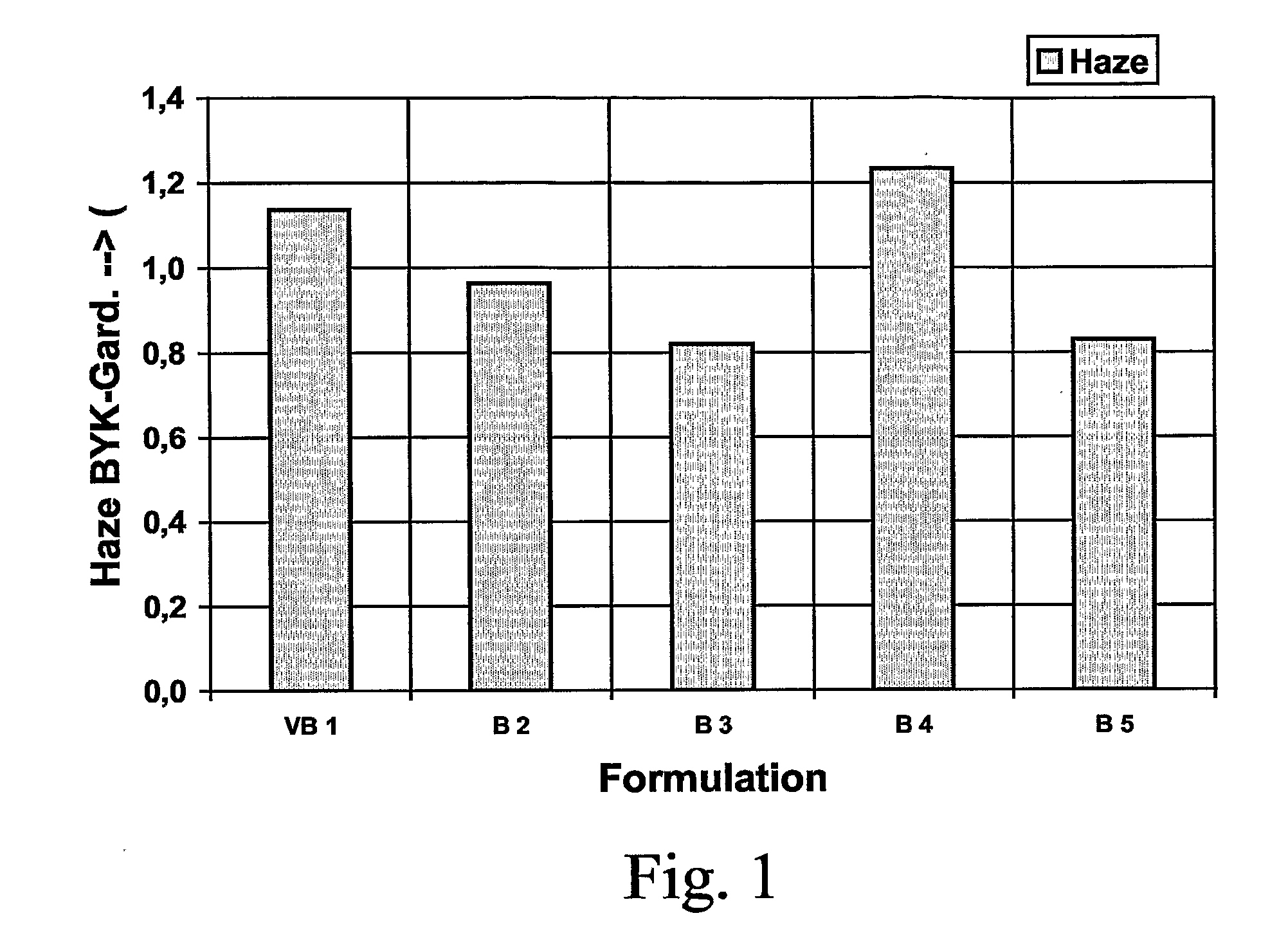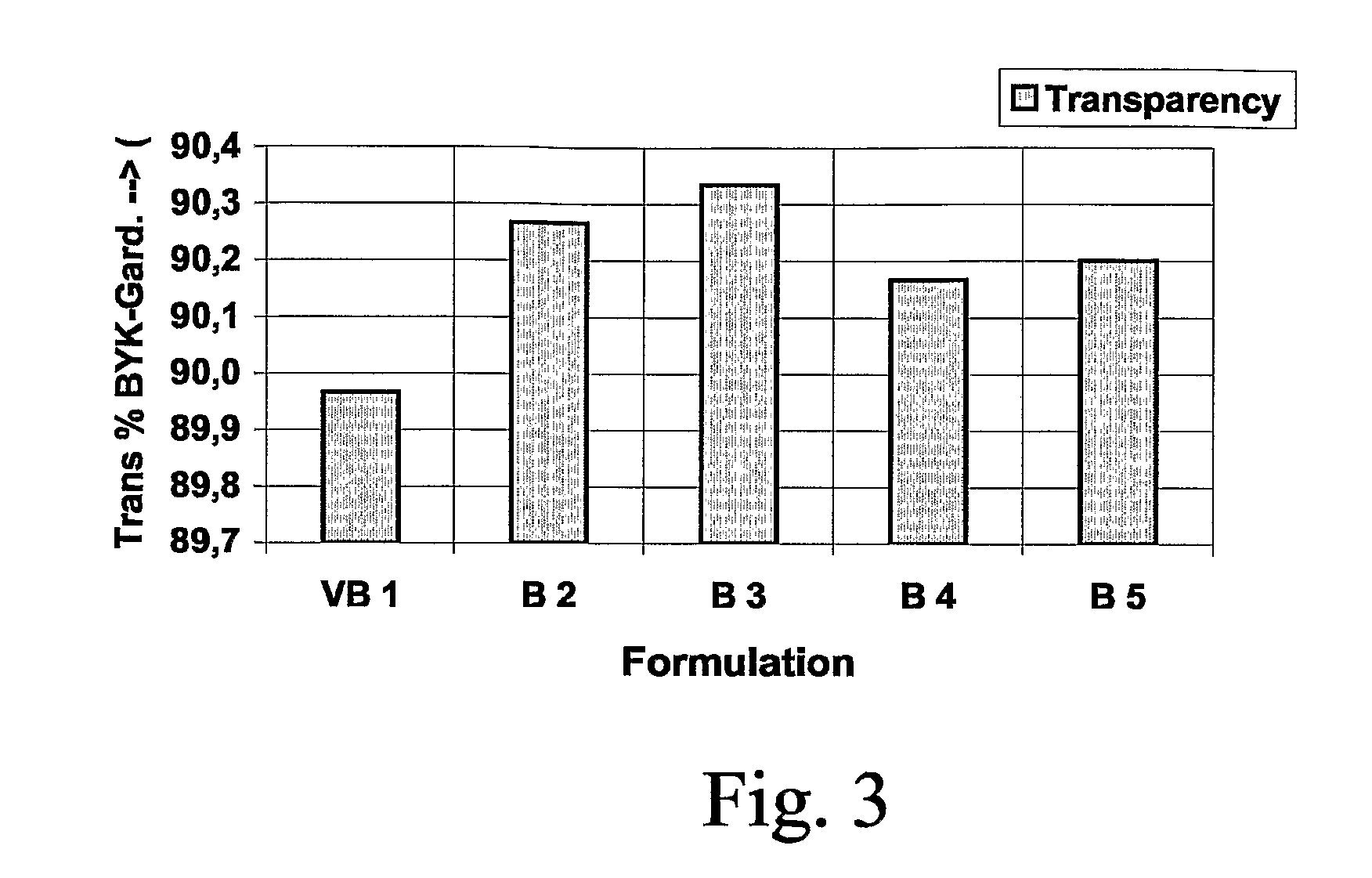Materials composites of a moulded article of transparent or translucent dyeable plastics moulding compounds
a dyeable plastics and composite material technology, applied in the direction of thin material processing, transportation and packaging, layered products, etc., can solve the problems of difficult to select additives, and difficult to meet the requirements of forming conditions, etc., to achieve perfect purity and quality, improve the rheological properties of the melt during forming, and excellent adhesion
- Summary
- Abstract
- Description
- Claims
- Application Information
AI Technical Summary
Benefits of technology
Problems solved by technology
Method used
Image
Examples
examples
Reference Examle 1
[0197] Highly transparent polyamide of the MACM12 type which has a Tg of 155° C. and a relative viscosity of 1.73 (0.5% m-cresol) was mixed with 4% of Grilamid TR MB XE3805 UV400, both being trading items of EMS Chemie AG, in the form of granulates and the mixture was extruded on a two-screw extruder (WP ZSK30, 280° C.), was cut into a granulate and was dried to a humidity below 0.06%.
[0198] This granulate was processed into plane-parallel lenses of 75 mm in diameter and 2 mm in thickness on an injection moulding machine. The lenses were measured by radiating light onto the convex side. UV absorption was below 99.8% up to 400 nm.
[0199] Light transmittance was 89.9%. The lens properties obtained were measured with a Byk-Gardner haze meter (FIGS. 1-3).
examples 2 , 3 and 5 (
Examples 2, 3 And 5 (According To the Invention): Reference Example 4
[0200] Several lubricants were admixed to the granulate mixture of Example 1 which was then extruded, was cut into a granulate, was dried to a humidity below 0.06% and was processed into test lenses in the same way. In Examples 2-5, UV protection was 99.8% up to 400 nm.
Example 2:+0.05% of paraffin oil (HTNP) (liquid);Example 3:+0.10% of paraffin oil (HTNP) (liquid);Reference Example 4:+0.10% of calcium stearate (CS) (powder);Example 5:+0.10% of saturated poly(oxyethylene)-sorbitanfatty acid ester (liquid), type: Polysorbat 20(PS20).
[0201] The comparison of the optical properties (FIGS. 1-3) shows that the liquid lubricants exhibit the lowest haze values (in %), the highest clarity (in %) and markedly increased transmission values (in %, by the Byk-Gardner method). With respect to transparency, the paraffin oil HTNP (0.1%) shows the highest value of 90.3%). The powdery calcium stearate exhibits the highest haze of...
reference example 6
[0202] Highly transparent polyamide of the MACM12 type which has a Tg of 155° C. and a relative viscosity of 1.73 (0.5% m-cresol) was mixed with 4% of Grilamid TR MB XE3805 UV400, both being trading items of EMS Chemie AG, in the form of granulates and the mixture was extruded on a two-screw extruder (WP ZSK30, 280° C.), was cut into a granulate was dried to a humidity below 0.06% and was mixed with orange pigments.
[0203] This mixture was processed into plane-parallel lenses of 75 mm in diameter and 2 mm in thickness on an injection moulding machine. The lenses were measured by radiating light onto the convex side. UV protection was 99.8% up to 400 nm.
[0204] Light transmittance was 49.3%. The lens properties obtained were measured with a Byk-Gardner haze meter (FIGS. 4-6).
PUM
| Property | Measurement | Unit |
|---|---|---|
| Fraction | aaaaa | aaaaa |
| Percent by mass | aaaaa | aaaaa |
| Percent by mass | aaaaa | aaaaa |
Abstract
Description
Claims
Application Information
 Login to View More
Login to View More - R&D
- Intellectual Property
- Life Sciences
- Materials
- Tech Scout
- Unparalleled Data Quality
- Higher Quality Content
- 60% Fewer Hallucinations
Browse by: Latest US Patents, China's latest patents, Technical Efficacy Thesaurus, Application Domain, Technology Topic, Popular Technical Reports.
© 2025 PatSnap. All rights reserved.Legal|Privacy policy|Modern Slavery Act Transparency Statement|Sitemap|About US| Contact US: help@patsnap.com



